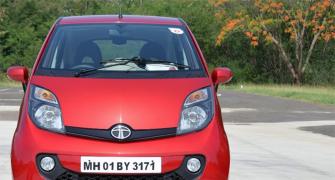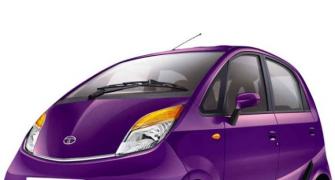 Code-named Kite, the vehicle is said to be a 1,200-cc hatchback
Code-named Kite, the vehicle is said to be a 1,200-cc hatchback
There is intense activity at Tata Motors’ Sanand manufacturing unit.
But this time, it has nothing to do with the famous Nano small car. Come December, this facility near Ahmedabad in Gujarat will roll out its first non-Nano small car.
Based on a completely new platform, the car -- so far unnamed and known by the code name ‘Kite’ -- will be a hatchback powered by a 1,200-cc engine.
It is seen giving a new lease of life to the Sanand plant, which has been struggling to maintain healthy capacity utilisation levels.
An email sent to the company did not elicit any response, but several people close to the plans, including government and vendor sources, confirmed the development.
While the ‘Kite’ will be based on a platform called X0, the company is also working on developing a car (code-named Pelican) based on the Nano platform.
Sources indicated the Pelican, expected to be ready by next year, would be a 900-1,000-cc hatchback.
On the X0 platform, a compact sedan might also be developed.
With the new offering to be rolled out in December, Tata Motors might be aiming to take on the Hyundai i10 and target the customers looking at an upgrade from the Maruti Alto range, says Abdul Majeed, automotive industry expert, and PwC India partner.
“I think the company will have a big basket, as Maruti’s Swift also has a similar size of engine. A lot will depend on the pricing,” he adds.
A Tata Motors vendor, which has manufacturing sites across India and had relocated its plant from Singur in West Bengal to Sanand in Gujarat with Tata Motors in 2008, says: “From the way things are at the moment, it seems the company will be able to meet the December rollout deadline.” This vendor does not wish to be named.
Another vendor source based in Gujarat suggests the company has indicated initial production volumes of 2,000-2,500 cars a month.
Tata Motors’ Sanand plant has an installed production capacity of 250,000 units a year (about 20,000 cars per month).
It has not been able to utilise its full capacity because of the lukewarm response received by the Nano. Recently, former Tata Sons chairman Ratan Tata, for whom the Tata Nano was a dream project, had remarked that branding the Nano as the ‘cheapest car’ was a mistake.
Earlier, Tata Motors had to relocate the ambitious Tata Nano project from Singur to Sanand in 2008, after facing opposition from a section of landowners led by Mamata Banerjee, now chief minister of West Bengal.
The whole crisis that preceded the Nano plant’s shift to Sanand is now part of business folklore in India.
The Gujarat government, then under Narendra Modi, had rolled out a red carpet for the Nano; the plant was swiftly allotted around 1,100 acres of land, as well as fiscal incentives.
The project, however, did not do as well as expected, with sales falling to as low as 948 units in April 2013 after peaking to 74,527 units in 2011-12.
While the company had aimed to have a demand of around 20,000 cars a month (and set up a dedicated plant for the car), it barely managed to touch that figure during 2013 and 2014 calendar years.
However, with new variants of the Nano, including the latest automated manual-transmission version, and a repositioning of the car as a city car for the youth, sales have lately shown some recovery.
Between April and July this financial year, the company sold 6,671 units of the Nano, 70 per cent more than the 3,904 Nanos sold during the corresponding period last year. The company produced 6,721 Nanos at the Sanand plant during this period, averaging around 1,680 cars per month.
Tata Motors has seen some revival in demand for its passenger cars, primarily on the back of some new launches like the Bolt and the Zest.
It sold 44,951 passenger cars between April and August this year, 34 per cent more than the year-ago period.
With these new launch, the company expects not only to utilise the Sanand factory better but also to boost its passenger car sales.
THE NANO STORY
2003: The idea of Tata Nano, touted as the world’s cheapest car, conceived
May 2006: Company announces setting up a dedicated plant for the Nano in Singur, 40 km from Kolkata
Oct 2008: After violent protests by farmers, led by Mamata Banerjee, Tata Motors announces it is pulling out of Singur; decides to relocate its Nano plant to Sanand in Gujarat
Mar 2009: Tata Nano launched in Mumbai; the two-cylinder, 624-cc petrol car (initially produced at the Pantnagar facility) is initially priced at Rs 1 lakh
Jun 2010: Tata Motors’ Sanand plant inaugurated
Oct 2013: Company launches CNG variant of the Nano
Jan 2014: Tata Motors launches the Nano Twist
May 2015: Company launches the GenX Nano range, with automated manual transmission and openable tail gate










